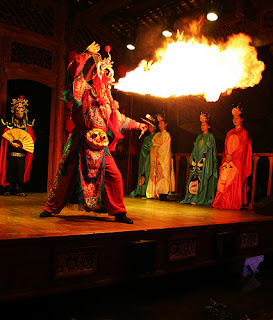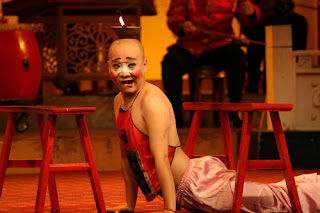In the previous articles in Chengdu series, we have talked about some leisure pastimes in Chengdu, like go to see the pandas, climb the Mount Emei and so on. In this chapter, we will talk about another leisure pastime in Chengdu-View the Sichuan Opera. Yes, I think you must think of the Changing faces, right?
Chapter Four
Ear-splitting Sichuan Opera: the Faster Face Changing, the More funs
For some local flavor in the evening, 200-year-old Sichuan Opera is an entertaining option. Ear-splitting Sichuan Opera is definitely an acquired taste which is a great enjoyment and an outstanding figure of Sichuan.
As one of the oldest and most interesting opera forms in Southwestern China, Sichuan Opera is a perfect blend of local dialect along with the customs, folk music, and dances from other regions.
Features of Sichuan Opera
With a repertoire of thousands of plays, Sichuan opera is said to have '3000 Tang stories, 800 Song tales and endless Three Kingdom anecdotes'. Being famous for its comedies in particular, Sichuan opera is delicate and vivid in acting, varied in performing, strongly local-flavored and humorous. The traditional performing formula is quite systematic in that it combines the stunts like face-changing, Tihuiyan, sword-hiding, fire-spitting and beard-changing with the plot and different characters, highlighting the romanticism of opera in a magical and exaggerated manner.
 |
| Changing Faces |
Sichuan Opera is known for three distinct features: Changing Faces, Spitting Fire, and Rolling Light. Changing Faces is a unique skill of Sichuan Opera, appearing almost magical to enthralled audiences. During the performance, the performers switch masks lightning fast to portray different characteristics and personalities of the characters.
Spitting Fire is yet another distinctive of Sichuan Opera. It is performed flawlessly in the Legend of White Snake, a key story that is a cornerstone of Sichuan Opera. The skill is hard to master, but when perfected is both entertaining and astonishing.
In a word, Sichuan Opera features vivid, humorous narration, singing, and acrobatics. Its special characteristic -- one that distinguishes Sichuan Opera from other theatrical traditions -- is its immense vitality and dynamic performances that always strive to bring out an individual's artistic abilities into play to ensure fresh material, variety, and creativity.
Besides, Sichuan Opera performances are always full of wit, humor, lively dialogues, and pronounced local flavors. --That’s why the opera's application to be enlisted as an Intangible World Heritage is currently pending.
The development of Sichuan Opera
 |
| Spitting Fire |
The development of Sichuan Opera is intrinsically linked to the natural conditions in Sichuan. The principal agricultural products cultivated in Sichuan's extraordinarily fertile soil include rice, tea, and mulberry trees, whose leaves are used in the traditional industry of raising silkworms. Rustic songs originally sung by boatmen and tea-plantation and rice-paddy workers developed into famous local folk songs, which, in a sense, can be regarded as the precursors of the province's great operatic tradition.
The music of Sichuan Opera
Musically, Sichuan Opera combines five different sonic systems -- gao qiang, hu qin, deng diao, tan xi, and kun qu--, all of which were still represented by their own independent troupes respectively until the end of the Qing Dynasty (1644-1911).
Founded in the province's capital city of Chengdu in 1912, the Sanqinghui troupe officially combined all five of these systems and fused them into a unique system of acting, singing, and instrumental music, where all of the librettos were written in the Sichuan dialect. The best-known style with most distinct characteristics of southwestern China is called gao qiang, which is distinguished by solos that are usually accompanied by sparse rhythmical accentuations played with wooden clappers.
This highly ornamental vocal style is distinguished by brilliantly artful glissando links, skillfully implemented vibrato embellishments around a single tone in the form of a delicately elegant yet energetically melodic ornamentation. The simplicity of the folk songs' melodic structures is often retained.
 |
| Rolling Light |
In addition, an orchestra chorus either comments on or repeats what has already been sung. A solo can also represent the chorus. In the past, members of the chorus also often doubled as percussionists and, like the percussionists, were clad in everyday garments and appeared in full view on stage. Nowadays, they perform in the orchestral area, which is situated along one side of the stage and is concealed from the audience.
The barbarian fiddle, or hu qin, was probably brought to Sichuan by the famous Peking Opera, where shrill-stringed are instruments are predominant. On the other hand, the masked theater known as deng diao, which evolved from exorcist ceremonies practiced in the villages, is clearly of Sichuan origin. Deng diao was only accepted very gradually and with much hesitation from professional performance troupes. Removable masks are distinct from the painted masks, which are traditionally worn by performers on stages elsewhere in China.
Alongside the dominant dialogues there are also numerous old folkloric themes that were typically heard in the past at rural festivals, weddings, and funeral processions. The accompanying instruments are primarily small drums and gongs.
Figures of Changing Face
- Tools of Changing Faces
 |
| Preparation of Sichuan Opera |
The performer prepares many special masks in advance made of gauze and elastic materials, such as sheep embryo membranes and rubber. After the masks are painted with different designs and assembled with a special transparent thread, they are pasted onto the performer's face.
The special masks for "changing faces" must be made to fit the performer's face to ensure that they are pasted as close as possible to the skin. Previously, the masks were discarded after a performance, but today they can be recycled with some minor repairs.
- Three Types of Face Changes
In the Wiping Mask routine the actor applies cosmetic paint in a certain position on his face. If the whole face is to be changed, the cosmetic paint is applied to the forehead or eyebrows; for changes on the lower half of the face, paint is applied to his cheeks or nose; or to other specific parts.
The Blowing Mask routine works with powder cosmetics, such as gold, silver, and ink powders. Sometimes a tiny box is placed on the stage; the actor draws near and blows at the box. The powder will puff up and stick to the face. Sometimes the powder is put in a cup. The secret to success in this act is to close the eyes and mouth and to hold the breath.
The Pulling Mask routine is the most complicated. Masks are painted on pieces of damask, well cut, hung with a silk thread, and the lightly pasted to the face one by one. The silk thread is fastened in an inconspicuous part of the costume. With a flick of his cloak the performer magically whisks away the masks one by one as the drama develops.
Places to watch Sichuan opera in Chengdu
 |
| Wu Hou Ci Grand Stage |
1. Wu Hou Ci Grand Stage (Chengdu Gu Xitai): the most famous old stage in Chengdu is Wu Hou Ci Grand Stage also called Chengdu Old Stage (Chengdu Gu Xitai). The Chengdu Gu Xitai reposes in Jie Yi Lou of Wu Hou Ci (Temple) – state level culture relic. It belongs to the rebuilt building complex completely in ancient stage style.
Wu Hou Ci Grand Stage is at present the largest archaized stage in Chengdu. It is an important place for reception of chiefs of state abroad and important Chinese leaders. Wu Hou Ci Grand Stage is also a famous film and teleplay shooting location.
Performances on this stage are strikingly and splendid including Sichuan opera, puppet show, shadow play, rolling lamps, tea steeping skills, face changing, and fire spitting. Many people do face changing and fire spitting at the same time is particularly excellent!
2. Sichuan Opera Theater: the full name of Sichuan Opera Theater is Sichuan Province Sichuan Opera Theater. This theater established early in year 1960 has promoted many universal praised plays. Sichuan Opera Theater has won great reputation in Southwestern Areas of China and even the whole country. The popular Sichuan opera will be on this theater including its unique stunts like famous face changing, fire spitting, lamps rolling and marionette figures.
3. Jinjiang Stage: Jinjiang Stage is the nest of Sichuan opera. The Sichuan opera "Fu Rong Guo Cui" is famous from this stage. Fu Rong Guo Cui is a performance by famous actors and actress and musicians. You will see shows like lamps rolling, fire spitting, acrobatics, shadow play, and the well know face changing.
P.S. Interested in Sichuan Opera now? How about come on with me and let’s share happy watching time over cups of tea together? Waiting for your replies~
No comments:
Post a Comment
Thanks for your comment and welcome to China!